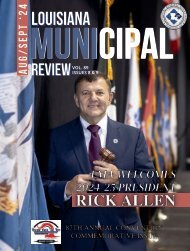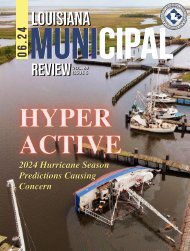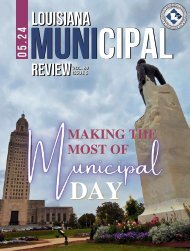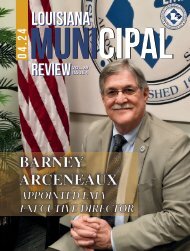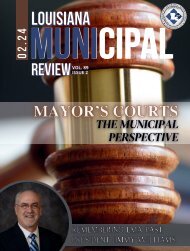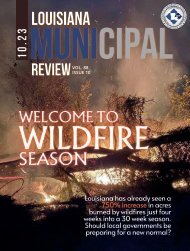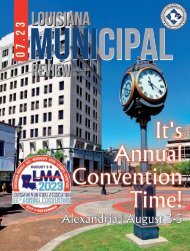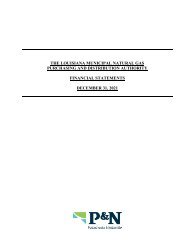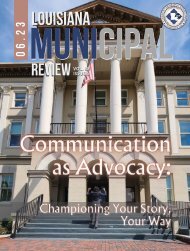Create successful ePaper yourself
Turn your PDF publications into a flip-book with our unique Google optimized e-Paper software.
Inside the LMA
Legal Briefs
SO, WHERE ARE WE NOW?
BY KAREN DAY WHITE, EXECUTIVE COUNSEL
Since 1976, the meetings of Louisiana’s
public bodies have been governed by our
Open Meetings Law (“OML”), which is now
codified in La. R.S. 42:11 et seq. In the 50
years since inception, the provisions have been amended and
refined to reflect the people’s sacred right to know as articulated
in Article XII, Section 3 of the Louisiana Constitution of 1974:
“No person shall be denied the right to observe the deliberations
of public bodies and examine public documents, except
in cases established by law.” One of the core tenets of the OML
is that meetings must be held in person.
Understanding all of the mandates and intricacies of the OML
was already daunting. Then along came COVID-19. As it became
apparent that Louisiana would not be spared from this
global pandemic, Governor Edwards began issuing a flurry of
executive orders aimed at providing legal clarity, protecting
the public, and, most importantly, slowing the spread of the
coronavirus. Among the first tranche of executive orders was
Executive Order 30 JBE 2020, which Governor Edwards issued
on March 16, 2020.
That order provided an exception to the OML requirement of
in-person public meetings as follows: (1) municipalities were
required to develop a means for council members to attend
essential meetings by teleconference or video conference;
(2) municipalities had to simultaneously develop a means by
which the public could observe and participate as otherwise
provided in the OML; (3) IF a council member wanted to participate
via remote means (or had to in order to comply with social
distancing mandates), and IF counting those participating
via remote means was required in order for the body to have
a quorum for conducting business, then remote participation
was an allowable exception to the OML during the pendency
of the public health emergency.
Utilizing the exact same language, this remote participation
process was extended via Executive Orders 41 JBE 2020, 52 JBE
2020, 59 JBE 2020, 75 JBE 2020, and 84 JBE 2020. So, for four
months, public bodies adapted to this new normal, developing
systems and integrating software to embrace remote attendance
by council/board members.
Then on July 23, 2020, the day before 84 JBE 2020 was set to
expire, 97 JBE 2020 was issued. Noticeably absent from this
new order was the remote attendance provision. So, does that
mean that we are back to the default OML mandate of in-person
meetings? Well, kind of.
During the 2020 Regular Session of the Louisiana Legislature,
the body nearly unanimously passed Act 302, which substantively
amended the OML to add an exception for meeting
during a gubernatorially declared disaster or emergency. La.
R.S. 42:17.1 became effective on June 12, 2020, creating a statutory
fix for meetings during states of emergency/disaster. The
law provides very clear boundaries and prerequisites for such
remote meetings. First and foremost, there is a requirement
that holding the meeting in person would be detrimental to
the health, safety, or welfare of the public.
But the most dramatic difference between the new law and
prior executive orders is the departure from a quorum-making
approach to a mandate that agenda items for these remote
meetings be limited to the following: (1) matters that are directly
related to the public body’s response to the disaster or
emergency and are critical to the health, safety, or welfare of
the public; (2) matters that if they are delayed will cause curtailment
of vital public services or severe economic dislocation
and hardship; and (3) matters that are critical to continuation
of the business of the public body and that are not able to be
postponed to an in-person meeting due to a legal requirement
or other deadline that cannot be postponed or delayed by the
public body.
The new law also provides clear notification requirements for
remote meetings. At least 24 hours prior to the meeting, the
municipality (in addition to posting the agenda at the location
of the meeting) must post the notice and agenda on its
website, email it to any member of the public or the news media
who requests notice of meetings of the public body, and
widely distribute the notice to every known news media outlet
that broadcasts or publishes news within the geographic area
within the jurisdiction of the public body. The notice must
be accompanied by detailed information about how the public
may participate in the meeting and submit comments on
agenda items.
Regarding the actual conduct of the meetings, the municipality
must provide a mechanism to receive public comment electronically,
both prior and during the meeting, and must ensure
that all parts of the meeting (other than executive session) are
clear and audible to all. Meeting participants must be clearly
identified, and public comments must be expressly identified,
acknowledged, and maintained in the meeting record.
It is likely that the subject of remote meetings will be revisited
in future legislative sessions. Technology and the changing
landscape of the modern workplace demand it. In the meantime,
remote meetings are reserved for dealing with time sensitive,
critical matters.
LMR | SEPTEMBER 2020 Page 7



